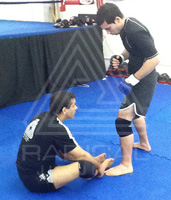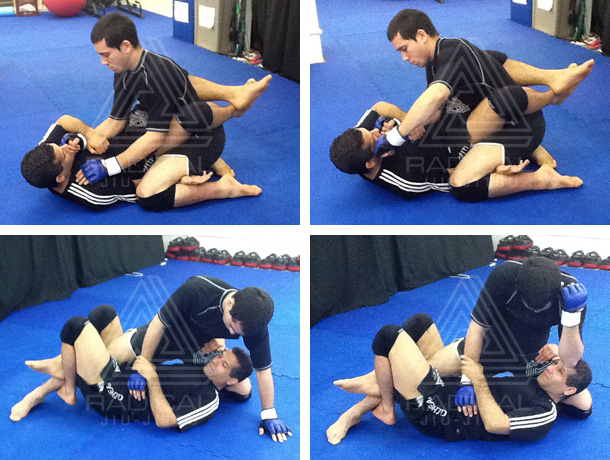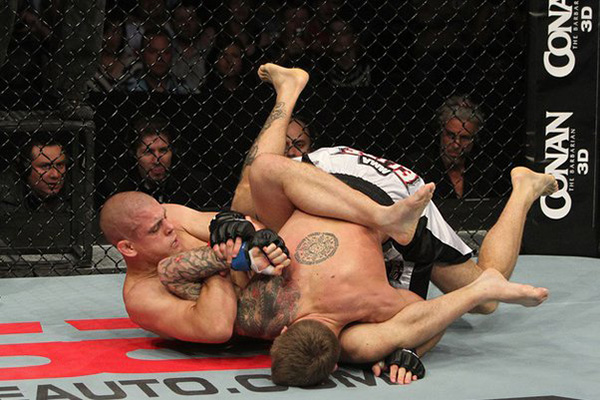“Jiu-Jitsu is a circle that some of us transform into a circus. We go and try more advanced and complicated options. But at the end of the circle we come back to the simple basic position.”
– Grandmaster Helio Gracie
In my last post I began to illustrate how guard play is different between MMA and grappling. The first major difference was the emphasis away from closed guard play. Take almost any grappling match and you’ll see sitting guards, inverted guards, 50/50 guards, very open and mobile guards, deep half guards etc. The fluid, mobile game of grappling is absolutely beautiful. The problem is that much of the grappling guard game favors guards that do not afford as much protection in MMA as closed guard.
But I’m sure many of you realize, simply crossing you ankles around someone’s waist alone won’t keep you protected from a skilled opponent intent on ground and pound. I can point to many, many MMA fights where closed guard has failed miserably. Wrestling-based fighters like Tito Ortiz, Randy Couture, and more recently, Joe Warren, Jon Fitch and Chael Sonnen have reached the upper echelons of the sport by punishing fighters in the guard.
So how can the guard be effective? The answer isn’t just to play closed guard, but change the way you think about playing all guards, closed included: every movement, every grip, every attack must revolve around protection from strikes.
Head Protection vs. Body Protection
In a fight, obviously, the most dangerous and potentially injurious attack is a head shot. There is a reason the very first thing you learn in a striking class is how to keep your hands up. However, in a sport grappling the danger begins when a part of your body controlled in some way. Therefore, because of the absence of striking, grappling is more and more moving away from strategies that make guard play combat realistic. Sport grapplers now often tend to lean forward, expose their head for sweep positioning, or sit up akin to a freestyle wrestling stance, sacrificing head protection in favor of body protection.
 Sitting guard, where players lead with their heads like wresters, is a perfect example of a pure grappling strategy. It is now one of the most common ways to play the bottom position. As an example let’s take this video from reknown grappler, Ryan Hall. Let me note that I do not mean this as a personal attack on Ryan. He is a fantastic person, and an inspirational grappling competitor. It’s just this video exemplifies a trend in grappling. He is certainly not the only player who plays like this. In fact, a majority of top grapplers like the Mendes brothers, Marcelo Garcia, and many others offer show a similar strategic approach.
Sitting guard, where players lead with their heads like wresters, is a perfect example of a pure grappling strategy. It is now one of the most common ways to play the bottom position. As an example let’s take this video from reknown grappler, Ryan Hall. Let me note that I do not mean this as a personal attack on Ryan. He is a fantastic person, and an inspirational grappling competitor. It’s just this video exemplifies a trend in grappling. He is certainly not the only player who plays like this. In fact, a majority of top grapplers like the Mendes brothers, Marcelo Garcia, and many others offer show a similar strategic approach.
In reality, this type of guard play has no combat relevance. Because it completely exposes the head in order to protect the legs, this position is absolutely defenseless against a top fighter intent on striking. While it is extremely common in grappling, you will almost never see it in MMA, precisely because exposing your head is about the worst thing you can do in a fight. It’s the most extreme example, but there are many other ways to play the guard that still leave the head vulnerable. Take a look at these common positions:

For every time I have seen one of these moves executed successfully in MMA, I can give you a score or more situations where they failed completely. Actually, it was watching a failed half guard many years ago that started my rethinking of my grappling approach for MMA. The fight was in UFC 51, and grappling savant Dave Terrell was matched up against Evan Tanner. I was so sure Terrell was going to twist Tanner into knots. But Terrell opted to play deep half for a sweep and dove his arm under his opponent without thinking about his head. It was a pure sport move and he was totally vulnerable. Tanner seized on the opportunity and pounded him into unconsciousness in seconds. It was a brutal KO. The thing was I had just spent weeks working the exact same set-up. But here was almost undeniable proof that the move was not fit for the cage.
So my point is that all guard work in MMA must be considered in light of how much protection it offers you from head shots. The guard, any guard, first and foremost must control an opponent’s aggression. Whether it’s half, full or whatever you have to think like a striker: protect your head. So how do you do that….guess what? Just go back to the old school.
The Clinching Guard
The closed guard is one of the most common positions in MMA, but without an appreciation of the danger of strikes, it isn’t any better than any other position. To prevent power strikes you have to kill the hips and that means must control your opponent’s posture.
Eddie Bravo’s style of clinching tight to an opponent is one approach to an effective MMA guard. But while the rubber guard is a new and innovative concept pioneered by Bravo, clinching in the guard is not. Look back to Royce’s epic fights and you’ll see the new school is really just a reworking of the old school. In every one of Royce’s fights he was always looking to control posture, and when he failed, he paid for it (remember Keith Hackney & Kimo…both got some good punches in when they were able to posture). His control of Dan Severn allowed him to avoid damage and set up the win. Clinching in the guard is the same as clinching in boxing, it’s where you go to avoid being punched in the face: it’s just a question of vertical versus horizontal.
The funny thing is this idea of clinching is one of the first things I learned as a white belt; to stay out of punch range, go either really far or super close, those are the safe zones. But somehow we seemed to have forgotten this simple principle. I can point to countless arm bar and sweep set-ups, both with and without the gi, that are very popular but have no clinching element or control of an opponent’s ability to punch. So we are basically sabotaging ourselves, drilling basics that leave us very vulnerable to being hit. While clinching in guard is absolutely critical for an MMA ready guard, in modern grappling it is something that isn’t as addressed. Nowadays in grappling sports it’s once the guard opens (if it ever closes) that the game really begins.
What Rorion Gracie and his sons refer to as the “punch block series” i.e. ways to block strikes in the guard, are required for promotion to Blue Belt in the Gracie Academy, but I know of no other major schools training this way on a regular, day-to-day basis. Why? Simply because there are no punches in sport grappling, therefor there is no need to train to defend them. Grappling competitors are playing to their rules. But in MMA you can’t ignore the danger of an open distance.
Carlson used to say that if you punch a black belt in the face he turns into a purple, punch him again and he’s a blue, once more and he’s back to white. These are wise words and something all Jiu-jitsu players who aspire to MMA must consider. In MMA it’s the tight, clinched guard (closed, half or butterfly) where a majority the fight must be played, and any move that sacrifices clinching or head protection should be discarded in lieu of techniques that are more combat relevant.
I probably sound very negative and critical. I want to make clear I have the UTMOST respect for all the top grapplers in both gi and no-gi. There is a tremendous amount of innovation coming from the sport world, a lot of which is transferrable to MMA. They have much to teach us. But in the guard both gi and no-gi sports often play in an artificial distance that does not emphasize clinching, and that, frankly, is very dangerous.
For my next post I want to introduce a variety of clinching guards that are great platforms of attack in MMA. Some are old standards, but I guarantee a few are new and will blow your mind.
